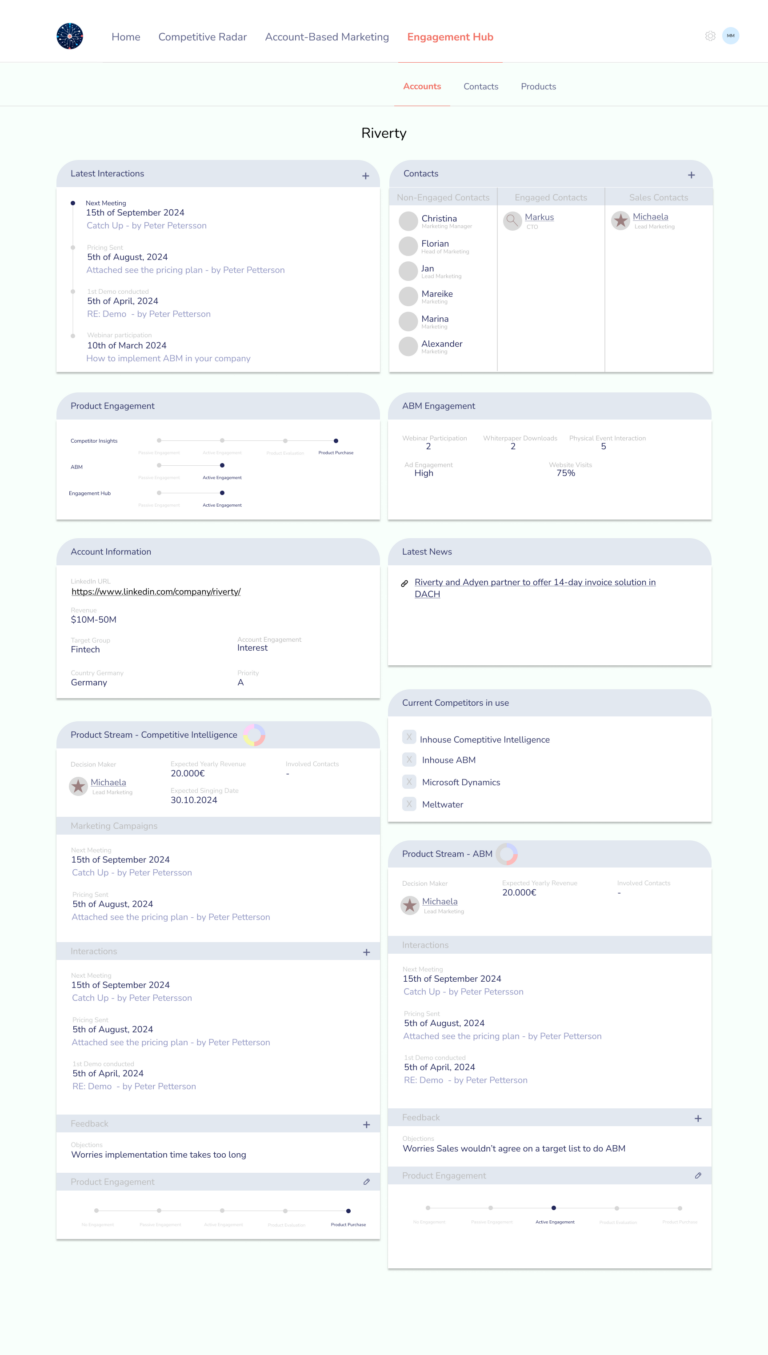In this article, I have compared InsightSync and Influ2 across features, pricing, reviews and ideal use cases so you can choose what fits your account-based marketing strategy.
I also show how ZenABM can act as a lean, affordable alternative or complementary layer due to its unique features.

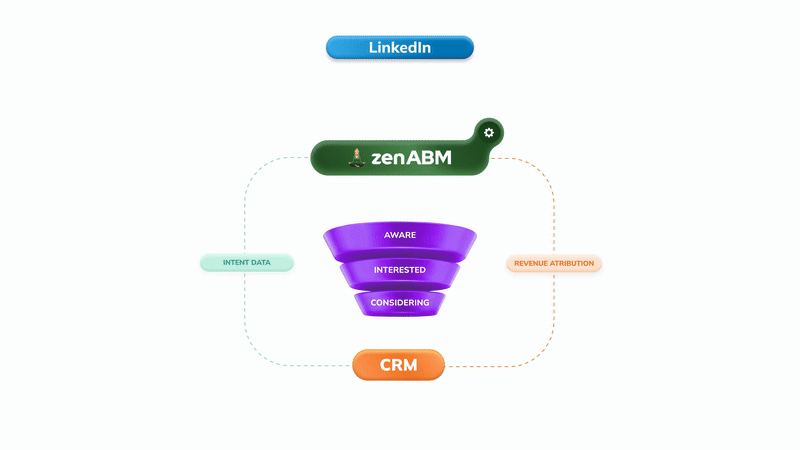
InsightSync vs. Influ2: Quick Summary
In case you’re short on time, here’s the gist:
- InsightSync is a CI plus ABM analytics platform that centralizes target accounts, engagement data, and competitor intel for tighter GTM alignment.
- Its three hubs are: Competitive Intelligence Hub (news, profiles, docs), ABM Hub (TALs, scoring, engagement timelines), and Engagement Hub (account and contact activity across channels).
- InsightSync is channel agnostic – campaigns still run in tools like LinkedIn and HubSpot while InsightSync acts as the analytics and coordination layer.
- Pricing is upper mid-market, starting around €699 per month, rising with onboarding services and custom CRM integrations, which can feel heavy for early or lean teams.
- Public review footprint for InsightSync is limited so far, with some practitioner-led credibility and internal success stories, but no presence yet on G2 or TrustRadius.
- Influ2 focuses on person-based ABM, targeting named contacts across channels with multi-channel ads and tracking engagement at the individual level.
- It reports impressions, clicks, and site visits per contact, feeds buyer intent and journey signals into CRM and sales tools, and offers automated ad journeys and revenue attribution.
- Pricing is opaque and perceived as very expensive, typically suited to high ACV enterprise deals, with users citing around $5 per engaged contact and “$$$$$” cost tier on G2.
- Reviews praise its precise targeting, sales-ready insights, integrations, and support, but call out high pricing, reporting gaps, and some personalization and integration limitations.
- A third alternative: ZenABM gives account-level LinkedIn ad engagement, plug-and-play engagement to pipeline dashboards, account scoring, ABM stages, CRM sync, first-party qualitative intent, automated BDR assignment, custom webhooks, an AI chatbot, and job title level engagement tracking, starting at $59 per month.
InsightSync Overview: Key Features, Pricing and Reviews
InsightSync is a newer account-based marketing and competitive intelligence platform that puts target accounts, engagement data, and competitor research into one shared system.
The pitch is simple: tighter alignment across GTM teams without adding yet another media platform.
Key Features of InsightSync
InsightSync bundles three modules in one ABM platform.
1. Competitive Intelligence Hub
This is InsightSync’s main differentiator versus ABM-only tools.
The Competitive Intelligence Hub tracks competitors and market moves in one place.
Unified News Feed

InsightSync pulls competitor content from news sites, press releases, and internal or external blog posts into a single feed, so you stop juggling multiple alerts.
You can tag items by competitor or topic, react to important updates, share them with colleagues, and set alerts for specific tags or keywords, for example, when a rival announces an acquisition.
Competitor Radar & Profiling

The CI Hub lets you maintain structured profiles for each competitor, including customer logos, partners, alliances, pricing notes, and positioning, so the whole team uses the same picture.
AI Document Search
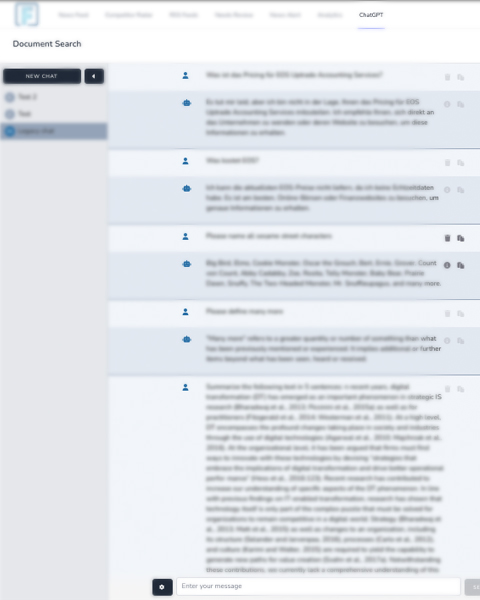
InsightSync ingests PDFs, whitepapers, and internal decks and lets you query them with AI search or pull concise summaries and key points.
2. Account-Based Marketing Hub in InsightSync
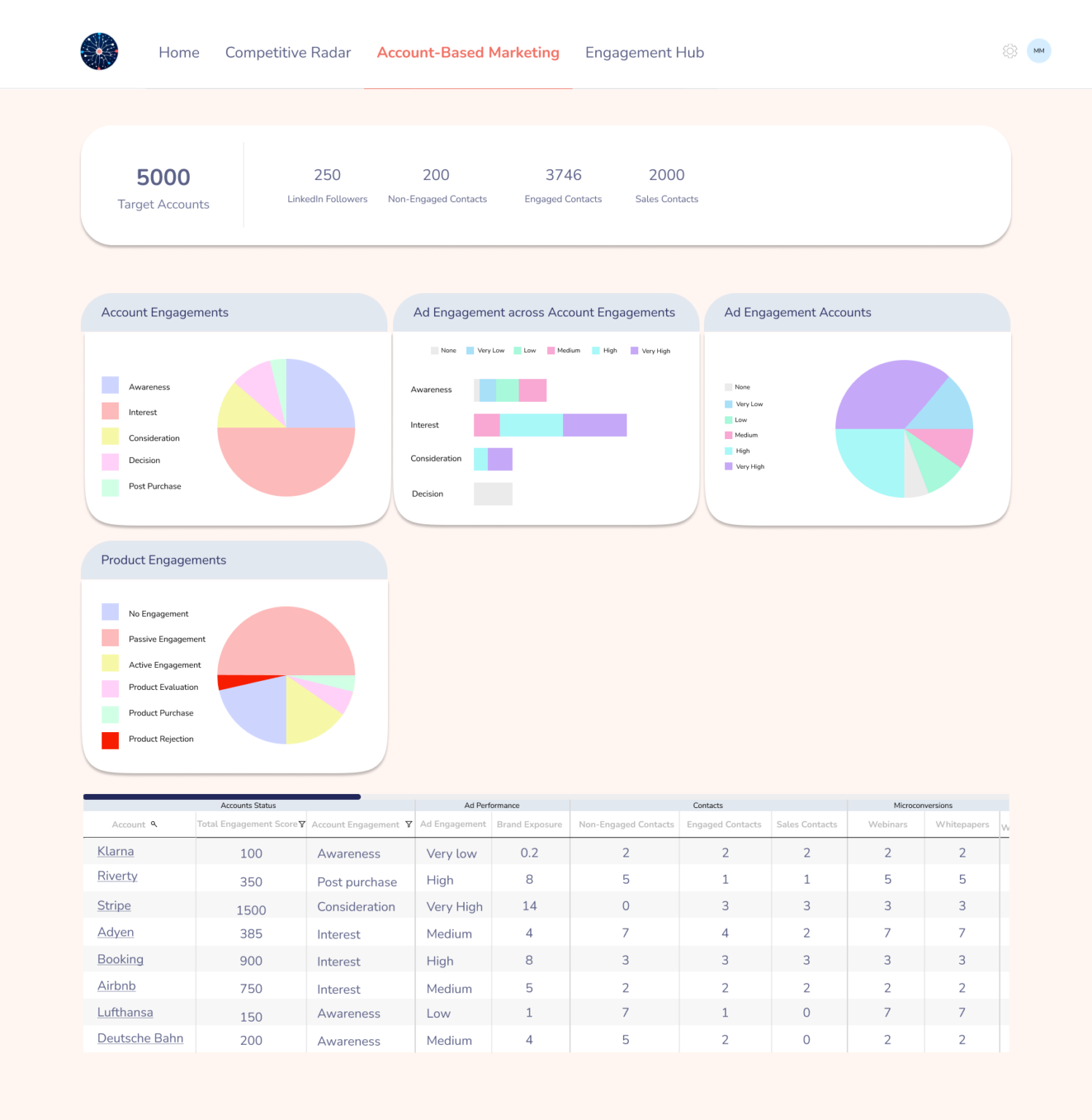
The ABM Hub focuses on three questions:
- Who are we targeting?
- What do we know about them?
- How are we engaging them right now?
It is the home for your account-based marketing workflows.
Target Account List Management
You can import or build your target account list from your CRM or CSV files.
Each account becomes a record that you enrich over time with firmographics such as industry, size, and tech stack from other tools or manual input.
Multi-channel Engagement Tracking
Once your TAL is in place, InsightSync tracks engagement from ads, email, and meetings in one timeline.
You can score actions, so demo requests carry more weight than casual newsletter opens, and high-scoring accounts surface as more sales-ready.
Real-Time Alerts & Optimization
InsightSync flags accounts that heat up or cool down so teams can double down where momentum is growing and step in when important accounts go quiet.
Account-level visibility also supports budget shifts toward active accounts and messaging tweaks for segments that lag.
Scalability & Workflow Automation
InsightSync is positioned to grow with your ABM maturity. It references automated workflows for personalized outreach, although public details are still limited.
Important context: InsightSync’s ABM Hub is channel agnostic and analytics-focused. It is not an ad network or full marketing automation platform like Demandbase or RollWorks. You still run campaigns in LinkedIn, HubSpot, and other tools while InsightSync ingests data for attribution and analysis.
For LinkedIn heavy teams, ZenABM offers a more direct path via the official LinkedIn Ads API.
It pulls company level impressions, clicks, engagement, and spend, scores accounts, syncs this data into the CRM as company properties, and routes hot accounts to BDRs automatically.




ZenABM then connects ad-engaged accounts with CRM deals and provides revenue and attribution dashboards so you can measure LinkedIn ABM impact on pipeline and closed revenue.

3. Engagement Hub
InsightSync’s Engagement Hub consolidates account activity such as web visits, ad clicks, email opens, and event attendance across contacts.
It highlights trends like rising interest or sudden silence so teams can focus on active accounts and re-engage those going quiet.
At the contact level, you can see who viewed pricing, who registered but skipped webinars, and who stays engaged, which helps sales tune outreach and marketers refine content.

These patterns help you map buyer roles and intent, infer funnel stage, and trigger timely follow-ups.
The Engagement Hub does not execute campaigns. Its job is to keep marketing and sales aligned around a shared view of account engagement and behavior.
InsightSync Pricing: How Much Does It Cost?
InsightSync sits in the premium bracket and targets teams that want a combined ABM plus CI backbone.
Here is the pricing as of late 2025:

- Self Service – €699/month: All three hubs with unlimited users. You handle setup and connect data manually or via the HubSpot integration, currently the only native CRM. Includes a 30-day free trial.
- Pro – €899/month (+ €3,500 one-time setup fee): Adds white glove onboarding. InsightSync’s team connects data, configures alerts and dashboards, and runs a one-off competitor and partner research project, plus quarterly reviews. The monthly step up from Self Service is modest, but the one-time service fee is sizeable.
- Custom – Contact for pricing: For teams on Salesforce, Microsoft Dynamics, Zoho, or Pipedrive. InsightSync is still building these integrations and offers early access. Custom plans add bespoke CRM work, technical consulting, prioritized features, and priority support.
InsightSync is cheaper than the biggest ABM suites, but still an upper mid-market spend. It works when you treat it as a CI system, ABM analytics layer, and light CRM adjunct in one.
Earlier stage or lean teams may still find the roughly €8K per year starting point heavy.
By contrast, ZenABM starts at about $59 per month for its starter plan, a small fraction of that.
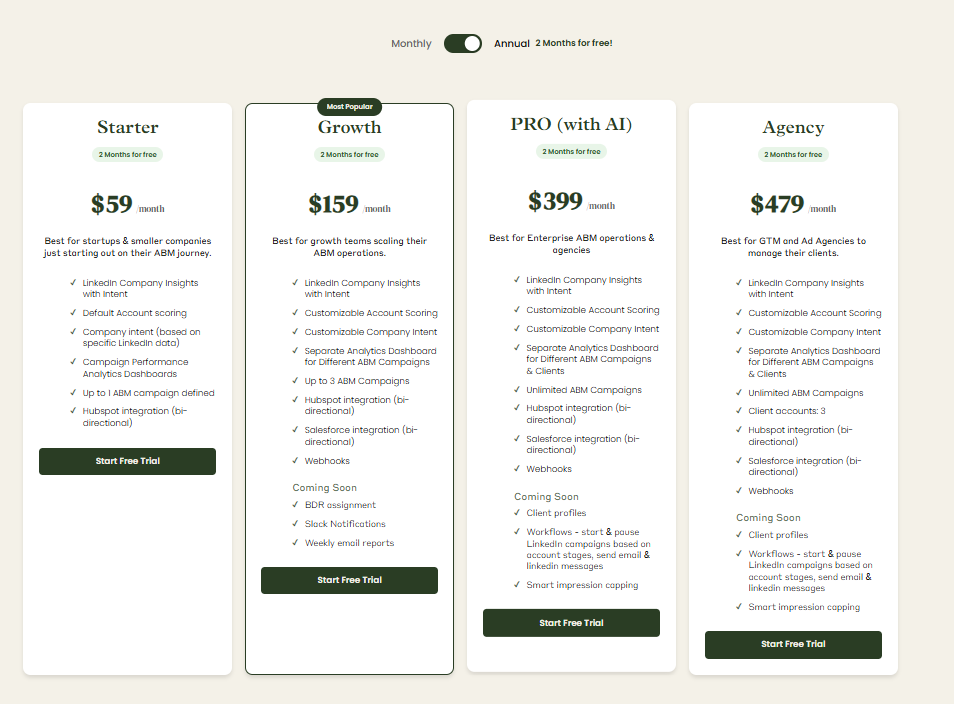
User Impressions and Reviews
Public feedback on InsightSync is still limited, but a few patterns show up:
- Origin story – built by practitioners: InsightSync began as an internal tool from a B2B marketing lead at Riverty before spinning out. ZenABM has a similar origin: Michael Jackowski built it for Emilia Korczynska at Userpilot to fix LinkedIn ABM reporting, then turned it into a dedicated LinkedIn ABM SaaS. Customers like Productive and Spear Growth report strong results with ZenABM.

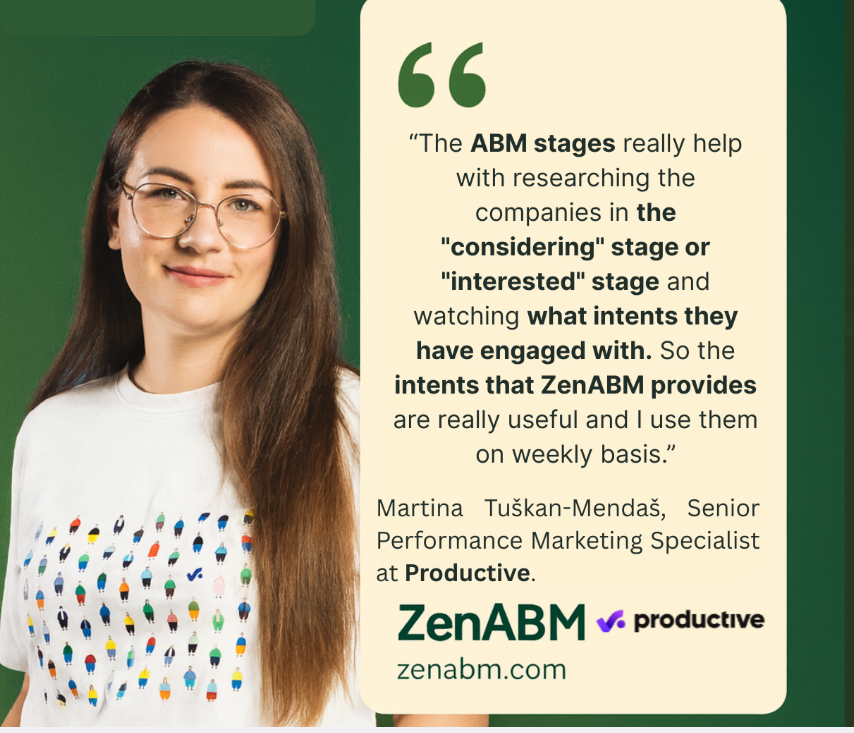
- Website testimonial: A testimonial from “John Doe, Riverty” says InsightSync has aligned marketing and sales and that the CI Hub alone saves hours each week.
- No G2 or TrustRadius footprint yet: As of November 2025, InsightSync does not have listings or reviews on G2 or TrustRadius.
Influ2 Overview: Key Features, Pricing, and Reviews
Influ2 is marketed as the first person-based account-based marketing platform.
It promises to target ads at specific individuals within your target accounts.
Let’s take a look at its features, pricing, and reviews.
Key Features of Influ2
Influ2 is about person-based advertising and ABM.
Let’s look at its core offerings:
Multi-Channel Contact-Level Targeting
Unlike many ABM platforms that stick to company-level audiences, Influ2 shows ads to specific individuals on major ad networks.
For example, you could target Jane Doe, CIO of Acme Corp, and have her see your ad on LinkedIn and later on a news site via Google Display.
No more wasting impressions on interns and random folks at the account who aren’t influencers in the deal.
How reliable is that matching?
Well, that is low 🙁
A study by Syft found that IP-matching accuracy for website visitor identification is a mere 42%.

Contact-Level Engagement Tracking
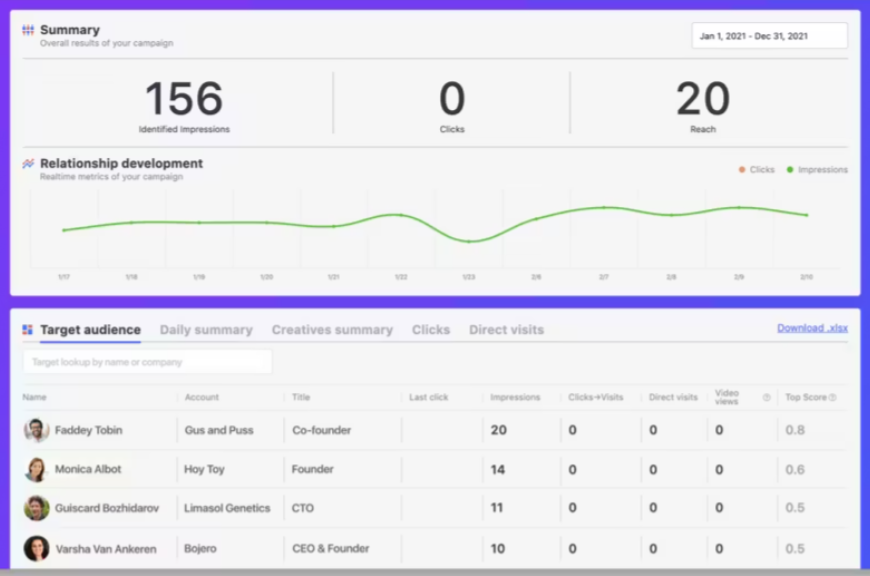
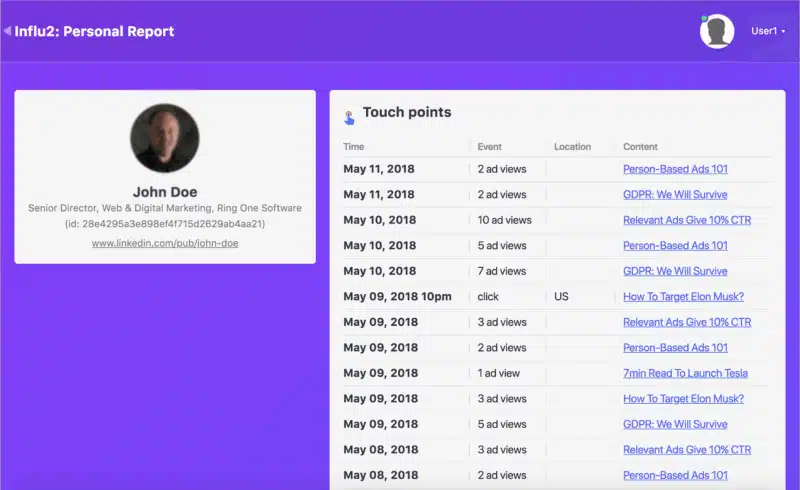
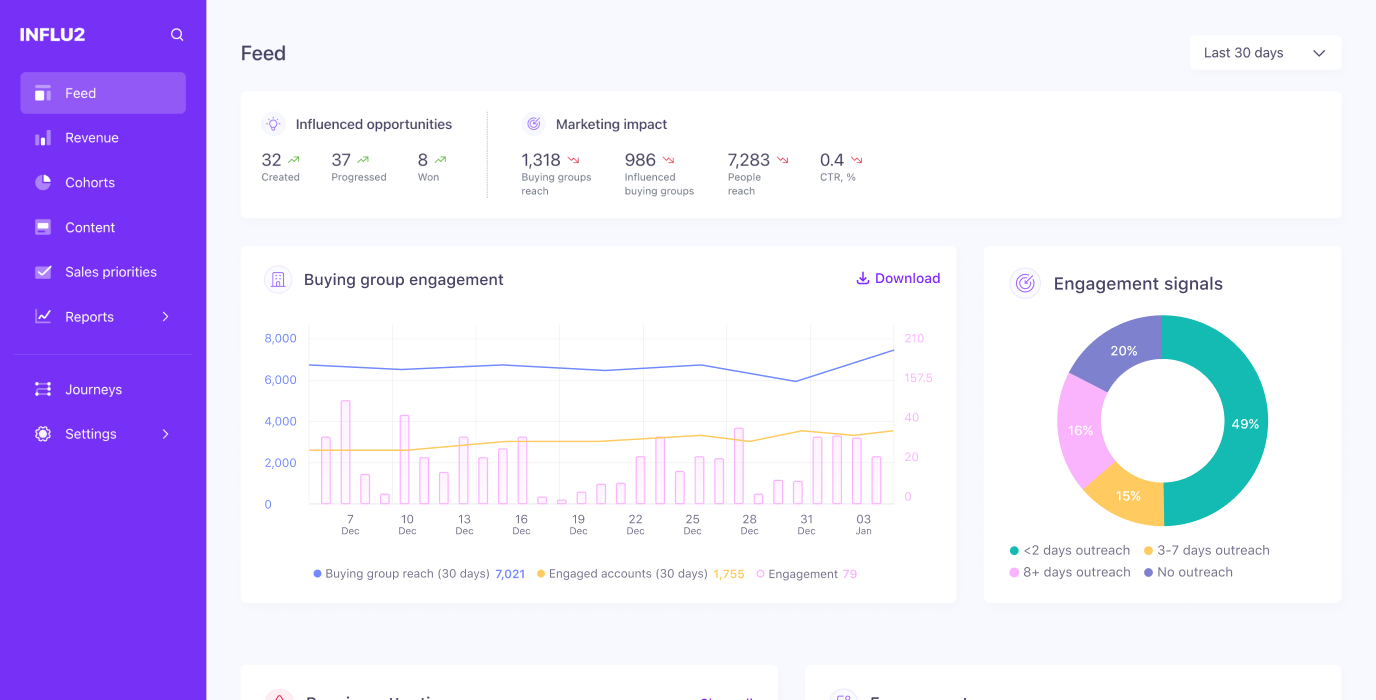
The platform doesn’t just blast ads; it tells you exactly who saw or clicked them.
Influ2 will report impressions, clicks, and even website visits by individual name for each target on your list.
Your sales team can get real-time intel like “John Doe (Senior Director at Dream Account) saw 45 impressions and clicked 3 of them.”
Armed with these contact-level intent signals, sales knows who’s engaging and can tailor outreach accordingly.
Buyer Intent Signals

Influ2 also tracks for third-party intent signals like keyword searches and the sites visited by your target contacts.
Pro Tip: Influ2 can surface third-party intent, like what keywords people may be searching or which sites they might be browsing, but that data is borrowed and often fuzzy. B2B buying decisions come from whole accounts, not a single contact’s browsing history, so these signals rarely map cleanly to real purchase momentum. ZenABM takes a cleaner route by giving you first-party company-level intent straight from your own LinkedIn ads. You see exactly which companies engaged with which feature-focused creative, which campaigns woke them up, and how their interest is shifting in real time.

Automated Journeys & Personalization

Influ2 enables automated ad sequencing based on engagement triggers.
If Jane Doe clicked Ad A, you can automatically move her to see Ad B next, mirroring a personalized buyer’s journey.
The platform lets you set up rules so each contact’s ad experience evolves as they progress (or don’t) through the funnel.
It’s like marketing automation workflows, but for ads aiming to keep each person engaged with content relevant to their stage.
In theory this delivers the right message to the right person at the right time.
In practice, it’s only as good as the logic you set and your content variety.
Some users have noted the platform’s dynamic personalization could be stronger and more flexible, so it may not quite be the choose-your-own-adventure experience the marketing materials imply.
Integration with CRM & Sales Tools
As a modern ABM tool, Influ2 plays nicely with the rest of your tech stack.
It offers integrations with major CRMs and marketing platforms like Salesforce, HubSpot, Marketo, Microsoft Dynamics, and marketing automation systems like Eloqua.
It also connects to sales engagement tools such as Outreach and Salesloft, and even collaboration hubs like Slack and Microsoft Teams.
The idea is to funnel those precious contact-level insights directly to where your sales and marketing teams live – e.g. pinging a Slack channel when a target account contact engages, or updating CRM lead records with ad engagement data.
Users generally praise these integration capabilities, though a few have struggled aligning Influ2 with certain existing workflows.
Implementation typically takes around one month on average, which is relatively speedy for an ABM platform (some competitors require a small army of consultants and several months to get rolling).
Analytics and Revenue Attribution

Influ2 platform provides dashboards to tie ad engagements to pipeline and revenue outcomes.
For example, you can see metrics like “982 buying groups influenced, 234 opportunities generated, 158 progressed, 17 won” – all attributed to people who saw or clicked ads. It offers revenue influence reports to show how ad campaigns contributed to deals.
Data Handling & Privacy
Given the person-specific nature, data privacy is a big consideration.
Influ2 markets a “unique privacy-first technology” where their algorithm matches contacts in a GDPR/CCPA-compliant way.
They are SOC 2 Type II certified for data protection.
Essentially, they use hashed emails and first-party data rather than shady third-party cookies to target individuals.
This is meant to reassure your legal team that uploading a list of contacts is done securely and that ad targeting doesn’t violate ad network policies.
Plus, the tool has built-in ad creative storage too:
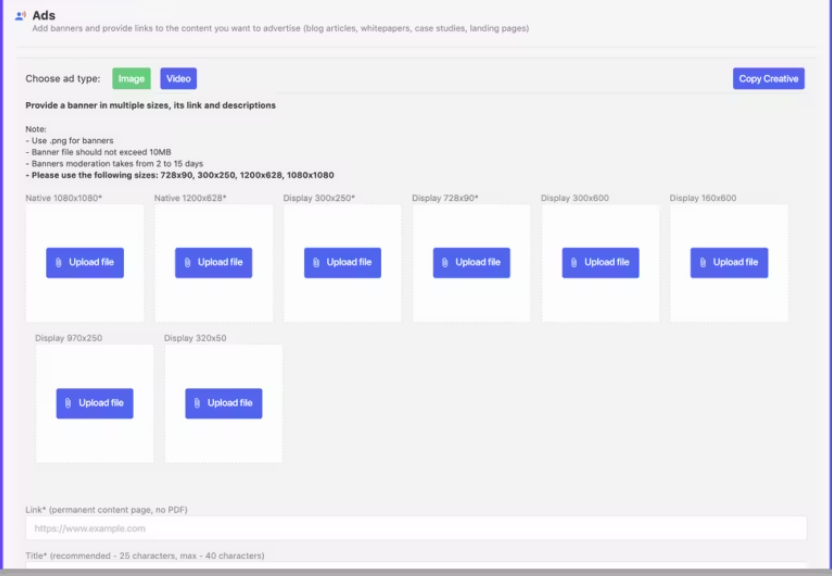
Sales Priorities

Influ 2 provides a list of hot accounts and the specific contacts within them that the sales team must attend to.
Influ2 Pricing: How Much Does It Cost?
If you’re hoping to find clear pricing on Influ2’s website, sorry, you won’t.
Influ2 follows the enterprise software tradition of “Contact us for pricing”, with custom quotes based on your situation.
But here’s what’s available on third-party sources:
- Their model is based on the number of people you target, bundling both the software and media spend into one flat fee. In other words, you pay a set rate to reach X number of contacts, rather than paying per click or impression directly. They pitch this as a simpler way to budget: no variable CPC/CPM surprises, just one price for your list size. Great, except it also means if you want to double your coverage from 5,000 to 10,000 people, expect that price to jump.
- So how expensive is it? G2’s data suggests users perceive Influ2 in the highest cost tier (“$$$$$”). One reviewer complained that “the pricing per reach is too high… Influ2 charges $5 for each contact engaged, called a credit.”
 Let that sink in: $5 per contact who interacts (clicks or even just sees an ad). If you have 1,000 contacts on your target list, you could be looking at ~$5,000 for them to be reached and that’s on top of whatever internal cost to produce ads and manage the program. That user also noted their results were underwhelming for the price: the target contacts didn’t even recall the brand after clicking ads.
Let that sink in: $5 per contact who interacts (clicks or even just sees an ad). If you have 1,000 contacts on your target list, you could be looking at ~$5,000 for them to be reached and that’s on top of whatever internal cost to produce ads and manage the program. That user also noted their results were underwhelming for the price: the target contacts didn’t even recall the brand after clicking ads. - Influ2’s own marketing says “only pay for the people you reach” and emphasizes no platform fees or integration fees. Essentially you’re pre-paying for guaranteed impressions to specific people. If those people are hard to catch online or have strict ad filters, that’s your risk. You’re still paying for the attempt.
- A positive note: G2 users report ROI in ~7 months on average after implementing Influ2.
 That implies that for some, the deals influenced by Influ2 within a few quarters justify the cost. The critical view is that Influ2 probably makes the most sense financially if your deal sizes are large (enterprise B2B deals worth $50k, $100k+ each). Spending, say, $50k a year on Influ2 to help close $1M in new business could pencil out. This isn’t a tool for the scrappy startup with $5k total ad budget; it’s for teams willing to invest serious money to get in front of hard-to-reach decision makers.
That implies that for some, the deals influenced by Influ2 within a few quarters justify the cost. The critical view is that Influ2 probably makes the most sense financially if your deal sizes are large (enterprise B2B deals worth $50k, $100k+ each). Spending, say, $50k a year on Influ2 to help close $1M in new business could pencil out. This isn’t a tool for the scrappy startup with $5k total ad budget; it’s for teams willing to invest serious money to get in front of hard-to-reach decision makers.
User Impressions and Reviews
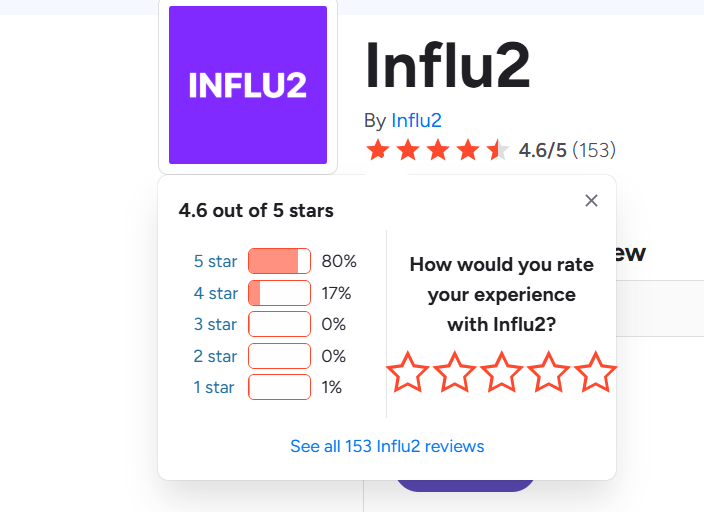
Influ2 enjoys a 4.6/5 average rating on G2 across 150+ reviews, which sounds stellar, but let’s dig into what users actually say.
What users applaud about Influ2:
- Precise Targeting & Insights: Over and over, marketers talk about the ability to zero in on the right people and see exactly what those people do. “I love the highly targeted insights on prospects – I can see which links prospects have clicked and content they viewed,” said one user. Another praised that it’s a “much smarter use of media spend, saving us $1000s a month in waste” by not showing ads to irrelevant audiences. The person-based approach clearly resonates with teams sick of paying for vanity impressions. Influ2 gives tangible data (by name) that can be acted on, which is gold for aligning marketing with sales. As one review summed up: “Influ2 has revolutionized our strategy by allowing us to hone in on exact decision-makers almost every time… the detailed contact-level intent data has empowered our engagement.” That kind of enthusiasm suggests Influ2 is delivering on its targeting promise for many.
- Seamless Integration & Workflow Alignment: Several users mention how easily Influ2 plugged into their existing systems and workflows. “
- Support & Customer Service: Influ2 apparently has exceptional customer support, with users highlighting “knowledgeable assistance and proactive account management.” The support team helps with campaign setup, analysis, and is very responsive despite time zone gaps. This hand-holding is crucial because the concept of person-based ads might be new to many marketing teams.
- Ease of Use (Once Up and Running): Some reviewers describe Influ2’s UI as intuitive and the platform as easy to use.
Where users see pain points or limitations:
- Reporting & Analytics Gaps: Even fans of Influ2 often wish the reporting was more robust. “The platform could benefit from enhanced reporting capabilities – more customizable options to analyze performance and ROI,” one review noted. There are multiple mentions of limited features restricting valuable insights and lack of certain analytics depth. Essentially, the dashboards are good for quick pipeline impact visuals, but if you want to slice-and-dice data or create custom metrics, you might be frustrated. Some found the reporting confusing or lacking visibility into certain performance details.
- Steep Pricing and ROI Concerns: We already touched on pricing. Users definitely feel the burn in their wallet. Beyond cost complaints, a critical theme is value for money. One sales-focused user bluntly said “the pricing per reach is too high” and questioned the engagement quality, noting targets didn’t recall the brand post-click. Some smaller companies likely feel priced out entirely. The credit system ($5 per contact) and annual contracts could also lock you in, so if you don’t see success in a couple of quarters, you’ve still paid for a year.
- Ad Performance and Creative Limitations: A few users pointed out issues around the ads themselves. For instance, one con mentioned “limited dynamic personalization” in ads and a desire for better match rates to target users.
- Integration Hiccups & Learning Curve: While integration breadth is a strength, depth can be a challenge. A few reviews mention integration issues, making it hard to align with their tech stack.
InsightSync vs. Influ2: Key Differences
Here is a direct comparison of InsightSync and Influ2 across core dimensions.
| Feature category | InsightSync | Influ2 |
|---|---|---|
| Core positioning | Competitive intelligence plus ABM analytics platform that centralizes target accounts, engagement, and CI data | Person based advertising and ABM platform that targets named contacts across channels |
| Primary focus | Clarity and alignment for GTM teams on who to target, how they engage, and what competitors are doing | Getting ads in front of specific decision makers and surfacing contact level engagement signals for sales |
| Main modules | Competitive Intelligence Hub, ABM Hub, Engagement Hub | Contact level targeting, journeys and personalization, CRM and sales tool integrations, attribution |
| Audience model | Account based. Focuses on target account lists, firmographic enrichment, and account plus contact timelines | Person based. Targets and reports on individual contacts inside buying groups at key accounts |
| Ad execution | No native ad delivery. Reads engagement data from channels such as LinkedIn, email, and events | Runs and sequences ads to specific people across major ad networks and channels |
| Intent signals | First party engagement from your tools, scored at account level to highlight sales ready companies | Contact level ad engagement and third party style browsing or keyword intent layered on top |
| Engagement view | Account and contact timelines across web, ads, email, meetings, and events | Per person reporting on impressions, clicks, and site visits for each targeted contact |
| Data and privacy stance | Ingests your internal data sources and campaign activity into one analytics layer | Markets a privacy first, SOC 2 Type II compliant approach to matching and targeting named contacts |
| Pricing model | Tiered euro pricing from around €699 per month plus setup and custom plans for additional CRMs | Custom enterprise pricing based on number of targeted contacts, often perceived as top cost tier |
| Cost dynamics | Fixed upper mid market platform cost that makes sense if you treat it as CI plus ABM backbone | Flat fee plus per contact style economics, which can become expensive as coverage and reach grow |
| Ideal team profile | B2B teams with existing ad and MAP tools that need a single source of truth for accounts and competitors | Teams with high ACV deals that can justify premium spend to reach and influence named decision makers |
| Review footprint | Limited public reviews and no major review site presence yet | Strong G2 rating with 150 plus reviews and consistent praise for precise targeting and support |
| Best use case | Aligning marketing and sales on which accounts to pursue, when, and with what context | Equipping sales with contact level ad engagement signals for priority outreach and follow up |
InsightSync vs. Influ2: So, Which Is Better for ABM?
InsightSync is better if your main problem is clarity and alignment across marketing and sales.
It centralizes target accounts, engagement, and competitor intel so teams agree on which accounts to prioritize while you keep execution in LinkedIn and your MAP or CRM.
Influ2 is better if your main problem is getting in front of specific decision makers and feeding contact-level engagement to sales, and you have large enough deal sizes to justify a premium, contact-based pricing model.
ZenABM as a LinkedIn-First, First-Party Lean ABM Alternative
There is also a third option: ZenABM.
ZenABM is built for teams that rely on LinkedIn as the primary ABM channel and want first-party accuracy, automation, and revenue visibility without the price or complexity of multi-channel suites.
Account-Level LinkedIn Engagement Tracking


ZenABM connects to the official LinkedIn Ads API and captures account-level data for all campaigns so you can see which companies see, click, and engage with your ads.
Because this is first-party data from LinkedIn’s environment, it is more reliable than IP or cookie-based visitor ID.
A Syft study puts IP-based identification at around 42 percent accuracy.

ZenABM treats LinkedIn ad engagement itself as first-party intent. When several people in one company keep engaging with your ads, that is a strong buying signal without rented intent feeds.
Real-Time Engagement Scoring + Full Touchpoint Timeline

ZenABM updates engagement scores as accounts interact with your ads across campaigns, so you can see who is heating up over short or long windows and let marketing and sales prioritize accounts that show real intent.
ZenABM also shows the full touchpoint timeline for each company:

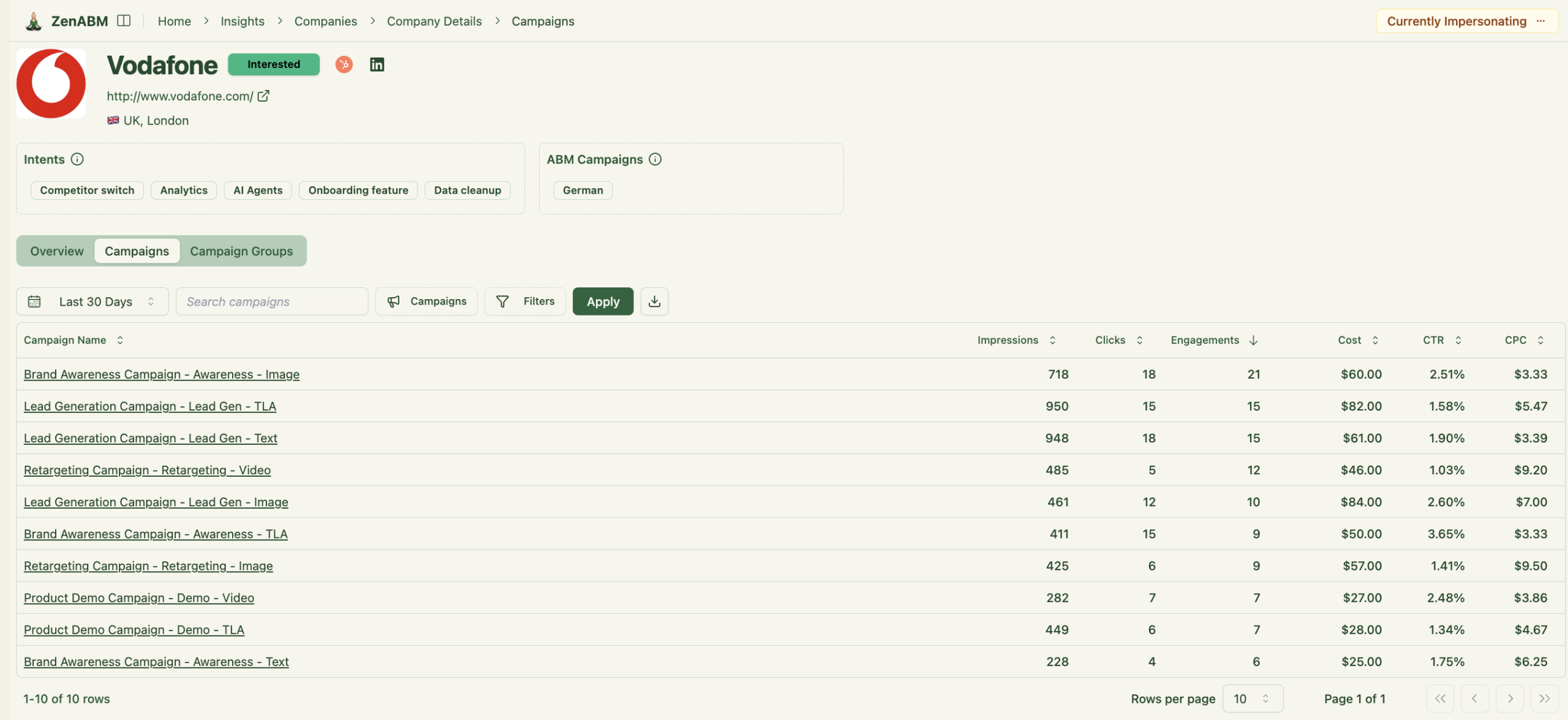
ABM Stage Tracking

ZenABM lets you define stages such as Identified, Aware, Engaged, Interested, and Opportunity and automatically places accounts in the right stage using scores and CRM data.
You control thresholds, and ZenABM tracks movement over time.
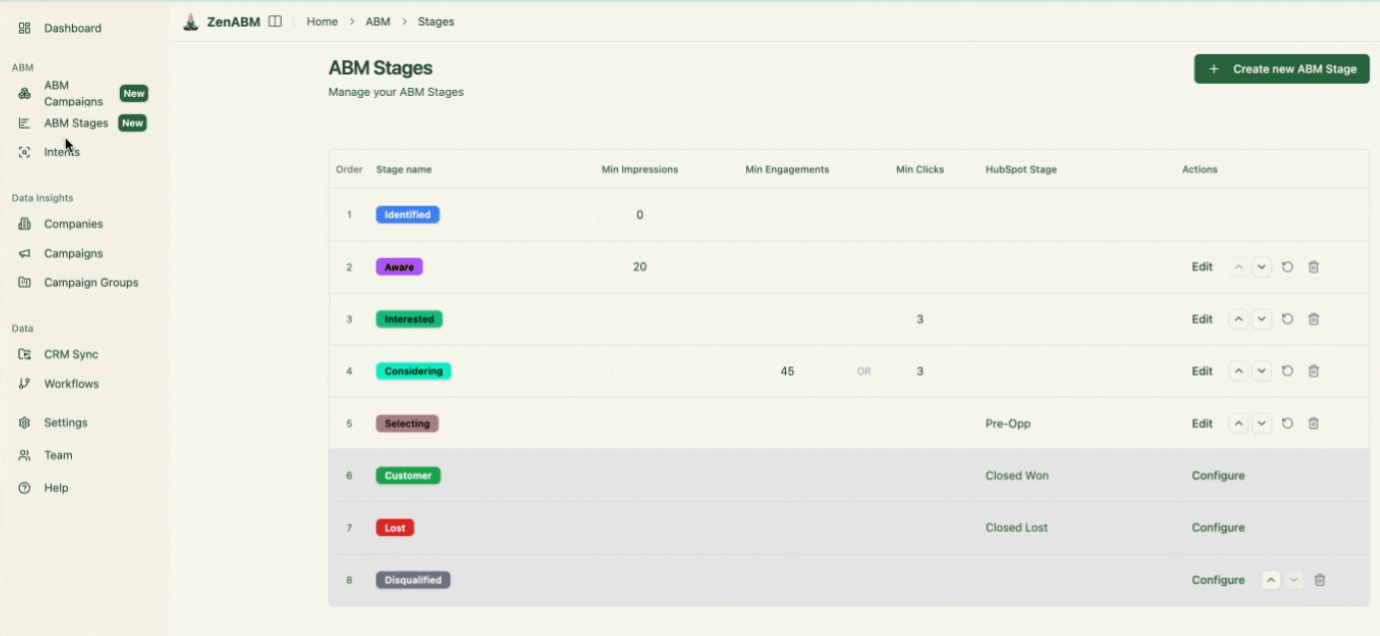

This gives you funnel visibility similar to larger suites, but powered by LinkedIn data.
CRM Integration and Workflows
ZenABM integrates bi-directionally with CRMs like HubSpot and adds Salesforce sync on higher tiers.
LinkedIn engagement data flows into the CRM as company-level properties:

Once an account crosses your score threshold, ZenABM updates the stage to Interested and automatically assigns a BDR.

Intent Tagging from Ad Engagement
ZenABM lets you derive intent topics from LinkedIn campaigns by tagging campaigns by feature, use case, or offer.
ZenABM then shows which accounts engage with which themes.
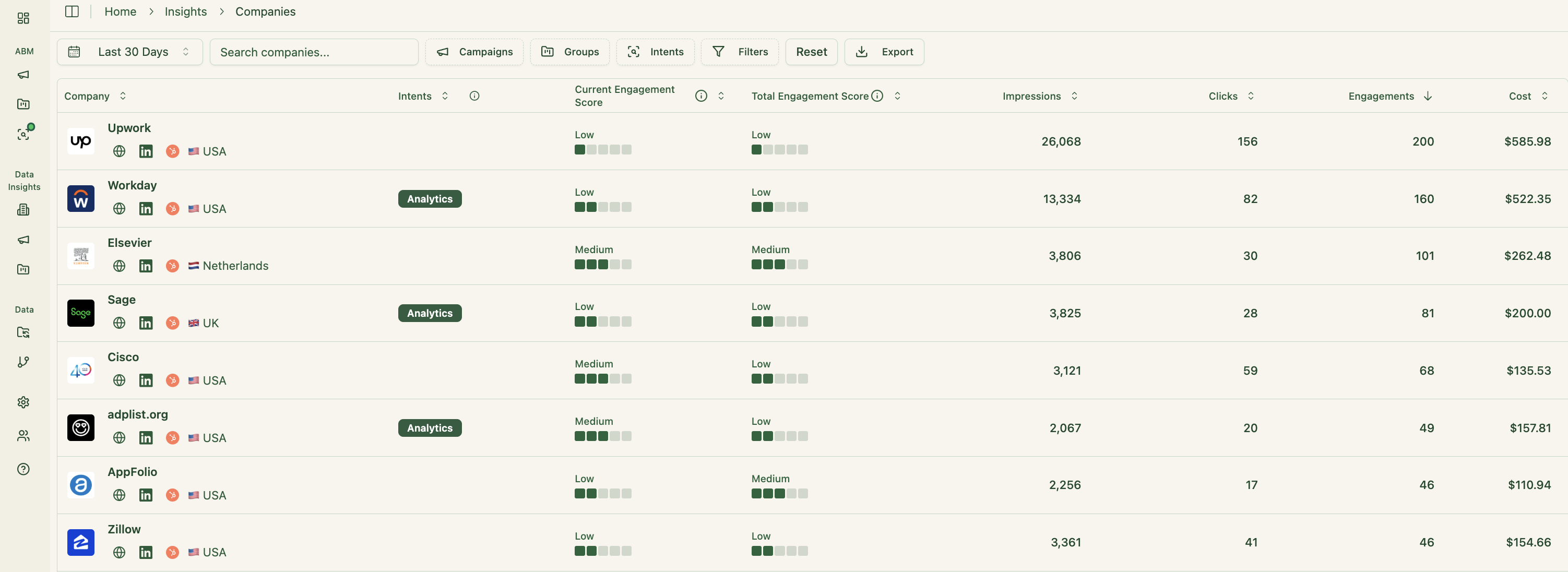
This is clean, first-party intent from owned interactions.
You can push these topics into your CRM so sales and marketing can tailor outreach to what each company has actually explored.
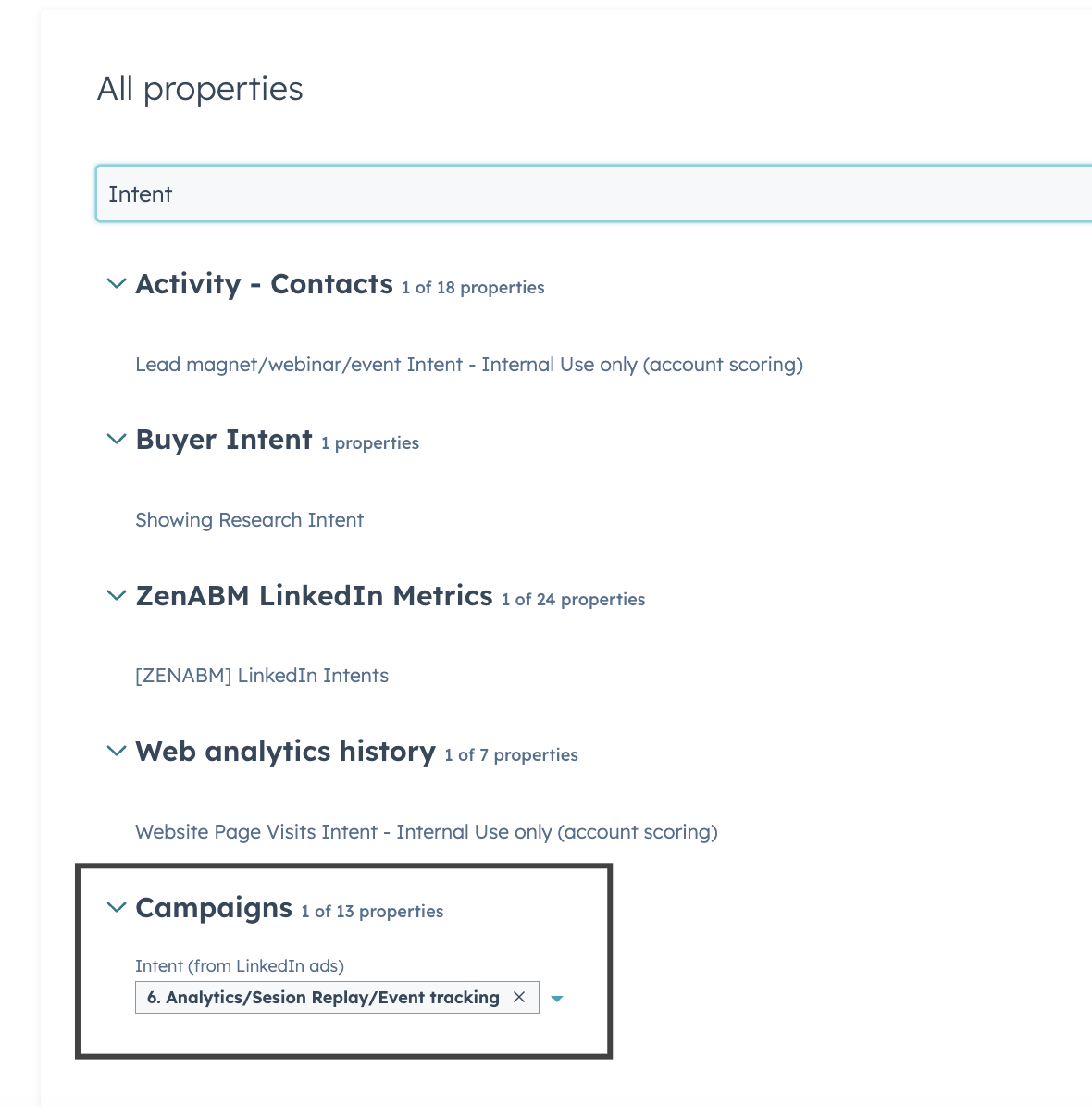
Built-in Dashboards and ABM Analytics
ZenABM ships with dashboards that connect LinkedIn ads to account engagement, stage movement, and revenue.
- You can monitor performance from high-level ABM campaigns down to LinkedIn campaign groups and individual ads:
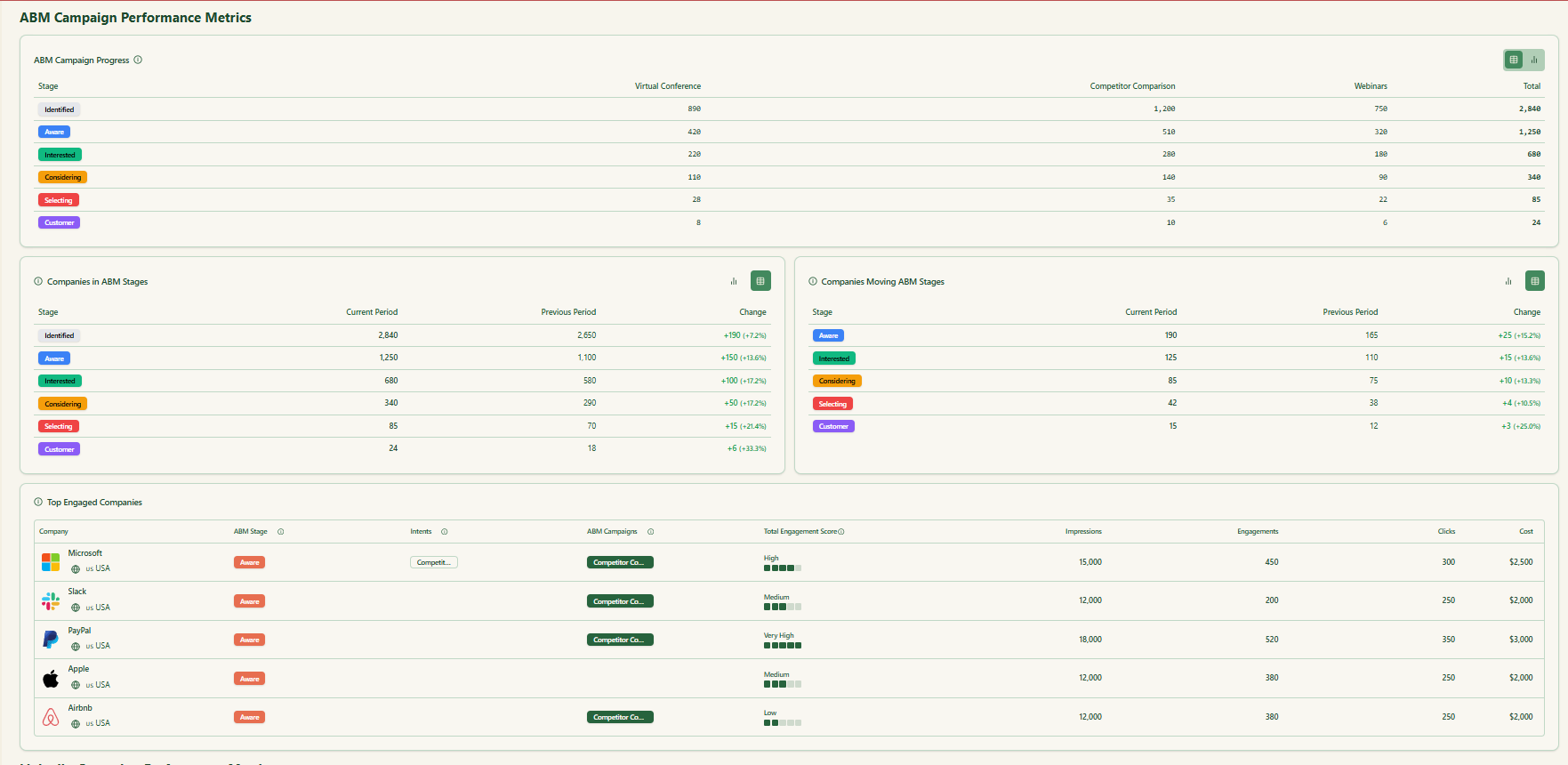

- Because ZenABM stores deal value and ad spend per company and per campaign, it can calculate ROAS, pipeline per dollar, and other revenue metrics and show pipeline contribution.

Custom Webhooks
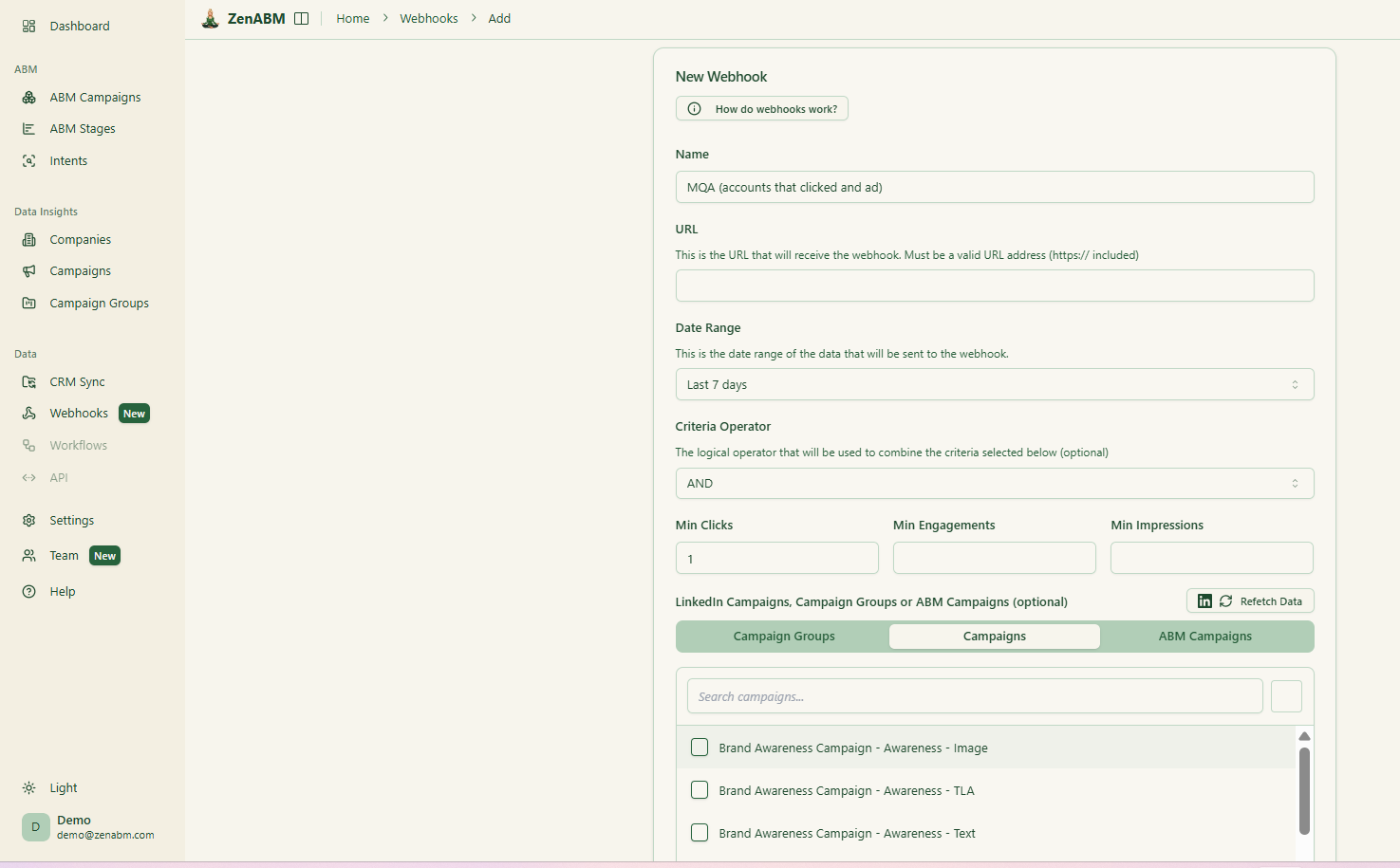
ZenABM’s custom webhooks let you push events into your stack, for example Slack alerts, enrichment flows, or other ops automations.
Job-Title Analytics
ZenABM shows which job titles engage with your creatives and gives dwell time and video funnel analytics.
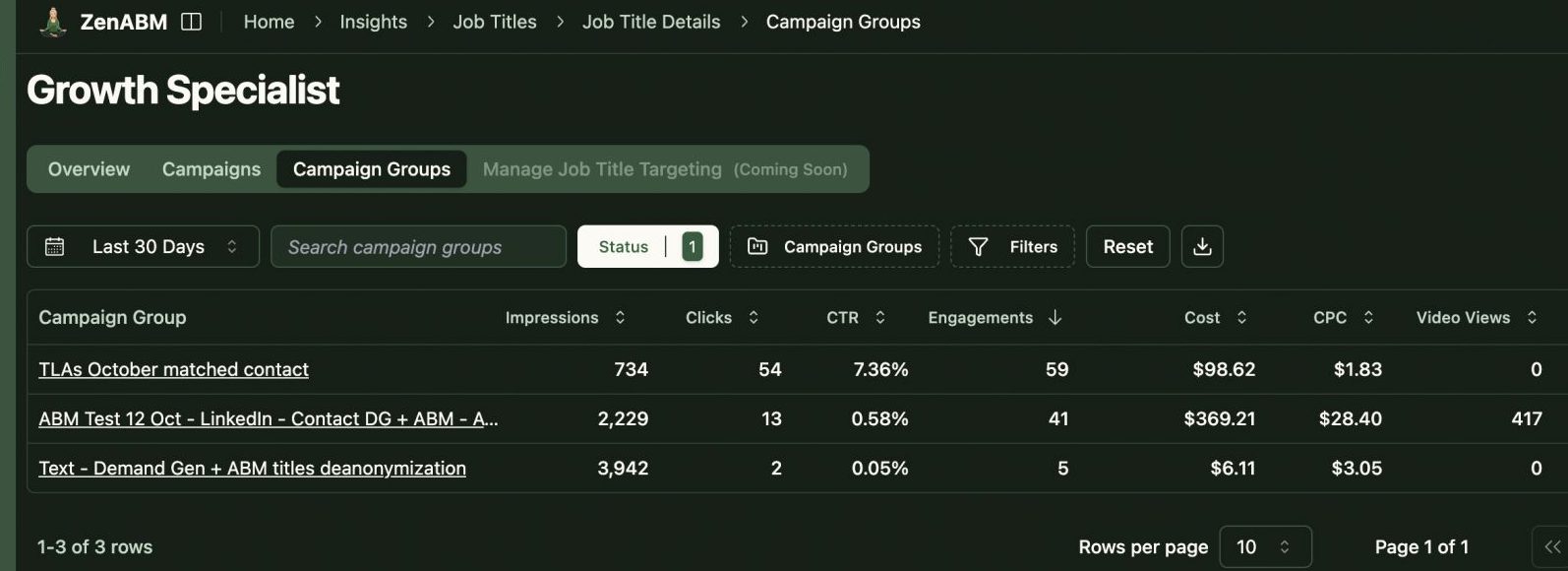
ABM Campaign Objects for True Multi-Campaign Attribution
Most tools treat each LinkedIn campaign separately. ZenABM lets you group several into one ABM campaign object so you can see performance across regions, personas, or creative clusters.
Instead of juggling fragmented reports in Campaign Manager, you see spend, pipeline, account movement, and ROAS for the entire initiative.
AI Chatbot to Analyze Your LinkedIn and ABM Data
ZenABM includes an AI chatbot on top of your LinkedIn API data and ABM model.
You can ask questions such as “Which accounts moved from Interested to Selecting last month?” or “What is my pipeline per dollar on retargeting?” and get answers based on live data.
Multi Client Workspace for Agencies
For agencies, ZenABM offers a multi-client workspace.
You can manage multiple ad accounts and clients in one environment, each with its own ABM strategy, dashboards, and reporting, instead of constantly switching accounts in Campaign Manager.
ZenABM Pricing

Plans start at $59 per month for Starter, $159 for Growth, $399 for Pro (with AI), and $479 for Agency.
The agency plan still stays under $6,000 per year.
All tiers include core LinkedIn ABM features. Higher tiers mostly increase limits and add Salesforce sync.
Plans are available monthly or annually, and every plan includes a 37-day free trial.
Conclusion
InsightSync works best as an ABM and CI backbone for B2B teams that already have ad and email tools and now need a shared view of accounts and competitors.
Influ2 fits companies that can afford to pay a high price to reach and track individual decision makers across channels.
For LinkedIn heavy ABM programs that want company-level engagement, qualitative intent, ABM stages, CRM sync, and revenue attribution without enterprise pricing or credit packs, ZenABM offers a leaner and more predictable path.
Try ZenABM now for free (37-day free trial) or book a demo to know more!


